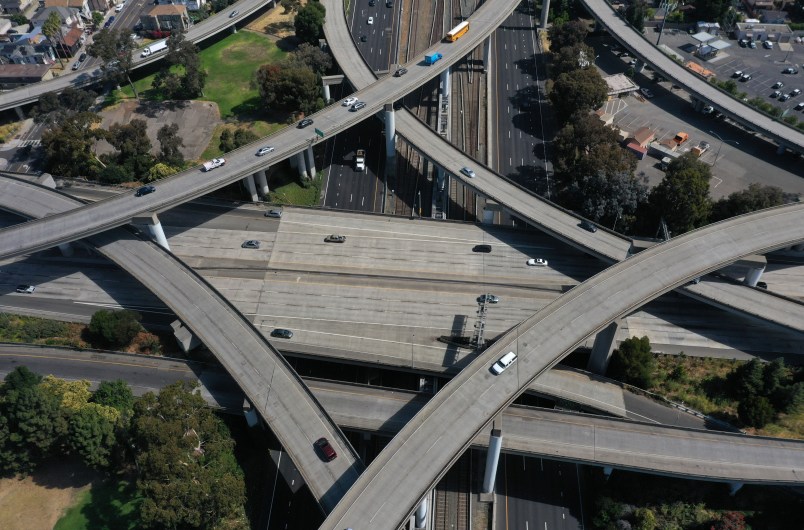SACRAMENTO, Calif. (AP) — California will outlaw sales of new gasoline-powered passenger cars and trucks by 2035, Gov. Gavin Newsom announced Wednesday, a move he says will cut greenhouse gas emissions by 35% in the nation’s most populous state.
His plan would not ban people from owning gas-powered cars or selling them on the used car market. But it would end the sales of all new gasoline-powered passenger cars and trucks in the state of nearly 40 million people.
“Pull away from the gas pumps,” Newsom said in announcing his executive order to state regulators to draw up guidelines. “Let us no longer be victims of geopolitical dictators that manipulate global supply chains and global markets.”
White House spokesman Judd Deere said Newsom’s order will hurt the economy and is “yet another example of how extreme the left has become. They want the government to dictate every aspect of every Americans’ life.”
California is the world’s fifth-largest economy and Californians account for more than one out of every 10 new vehicles sold in the U.S. — market clout that means Newsom’s order could have a huge impact on the country’s auto industry and the global effort to reduce pollution and combat climate change.

California already has rules mandating a certain percentage of new car sales must be electric or zero-emission vehicles. This rule would make California the first U.S. state with a plan to phase them out completely.
At least 15 other countries have already made similar commitments, including Germany, France and Norway.
Tailpipe exhaust from cars, pickups, tractor-trailer rigs and other transportation are the single largest source of air pollution. Jessica Caldwell, executive director of insights at the Edmunds.com auto pricing site, said Newsom’s announcement “does seem like this is a significant shot fired against” the internal combustion engine.
She expects the California announcement to trigger high-level meetings at all the auto companies which were moving toward electric vehicles but didn’t expect a zero-emissions mandate in 15 years. Automakers may have to rethink manufacturing and capital spending plans because of the mandate, she said.
The Alliance for Automotive Innovation, which represents most automakers including Ford, which Newsom lauded for its anti-pollution efforts, said that although the industry is committed to more electric vehicles and will work with California, markets can’t be built with mandates and bans.
CEO John Bozzella called for combined efforts involving local, state and federal governments as well as the auto industry and other businesses. “It will require increased infrastructure, incentives, fleet requirements, building codes, and much more,” Bozzella said in a statement.
Roughly a dozen states follow California’s lead on auto emissions standards that are more restrictive than federal rules. If those states follow suit on zero-emission vehicles, it could have a huge impact on the U.S. automobile industry.

Meantime, President Donald Trump wants to roll back tougher Obama-era auto emissions standards and is battling California to force it to comply.
Newsom’s order directs the California Air Resources Board to develop and approve regulations to meet the 2035 deadline. He also ordered them to make a rule requiring all medium and heavy-duty trucks be 100% zero-emission vehicles by 2045 “where feasible.”
Phasing out gas and diesel-powered vehicles would mean less pollution threatening the health of Californians, said Fred Krupp, head of the Environmental Defense Fund.
It would be good for the state’s economy as well, Krupp said in a statement. “This plan positions California to win a new generation of jobs building affordable zero-emission vehicles — jobs that Europe and China are also hoping to capture,” he said.
Newsom also directed state agencies to speed up development of charging stations across the state and called on the Legislature to eliminate new fracking licenses by 2024.
Fracking is a technique that allows energy companies to extract huge volumes of oil and gas from shale rock deep underground. It involves injecting high-pressure mixtures of water, sand or gravel and chemicals into rock. Fracking opponents say the chemicals involved threaten water supplies and public health.
Kassie Siegel, director of the Center for Biological Diversity’s Climate Law Institute, called Newsom’s order “a big step” but said it “provided rhetoric rather than real action on the other critical half of the climate problem — California’s dirty oil production.”
“Newsom can’t claim climate leadership while handing out permits to oil companies to drill and frack,” she said. “He has the power to protect Californians from oil industry pollution, and he needs to use it, not pass the buck.”
California has a goal of relying 100% on clean, renewable energy by 2045. Gasoline and diesel-powered cars and trucks are the biggest impediment to reaching that goal as they account for more than half of the state’s carbon pollution.
The order comes as massive wildfires have burned a record 5,600 square miles (14,500 square kilometers) in California this year. Experts say the size and intensity of the fires are aided by warmer temperatures and years of drought brought on by climate change.
___
Associated Press writers Tom Krisher in Detroit and Ellen Knickmeyer in Oklahoma City contributed to this report.



